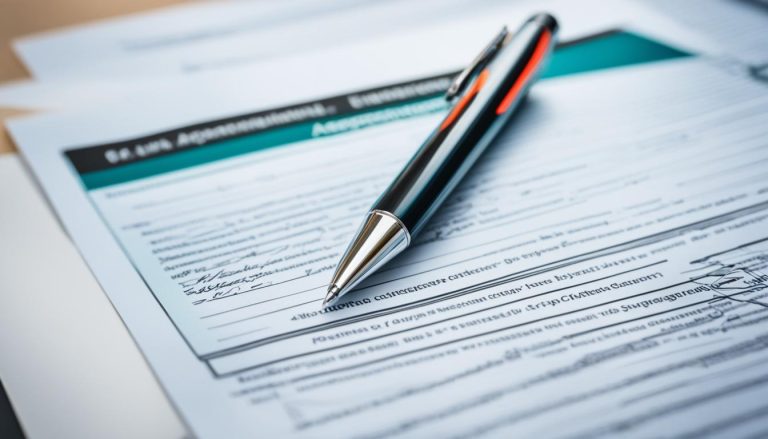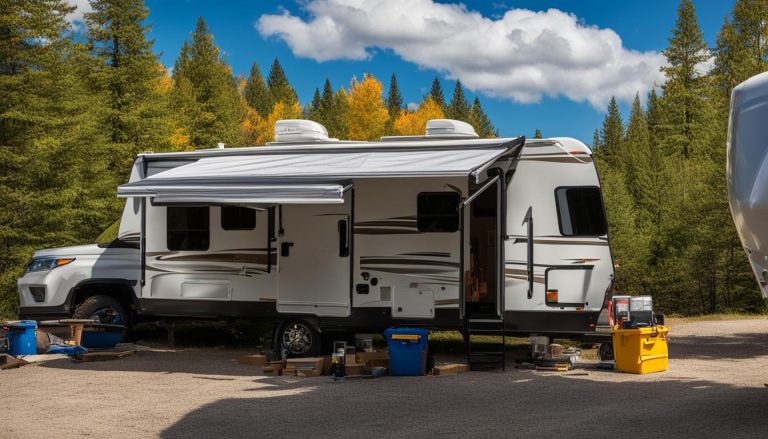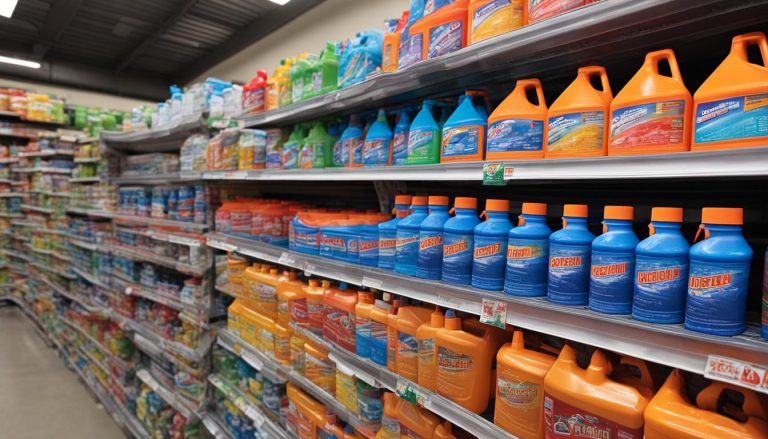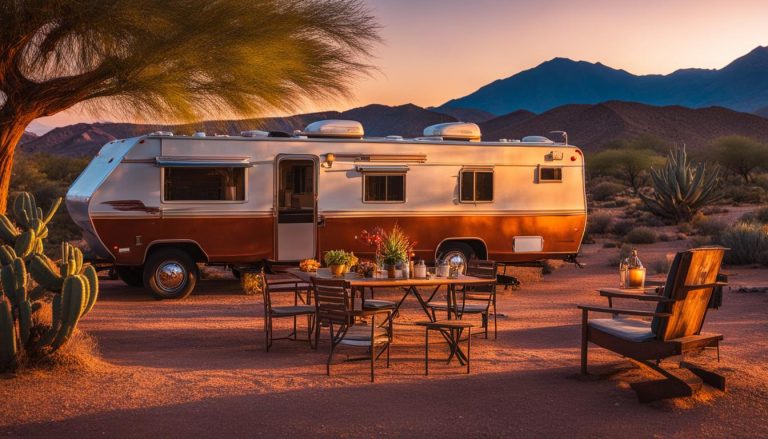Sell Your RV Fast: Tips on How to Get Rid of RV
gorvlifestyle.com and its partners may earn a commission if you purchase a product through one of our links
Selling your RV can sometimes feel like a daunting task, but with the right strategies, you can make the process easier and more successful. Whether you’re looking to upgrade your RV or simply want to let go of it, these tips will help you sell your RV quickly and effectively.
One of the first steps to consider is timing. Starting the selling process a few months before the summer camping season can increase demand and attract potential buyers. By preparing your RV in advance, you’ll be ready to hit the market when interest is at its peak.
Next, it’s important to depersonalize and deep clean your RV. Removing personal belongings and giving the interior a thorough cleaning will make it easier for potential buyers to envision themselves in the space. Consider having your RV serviced to ensure it’s in top condition and fix any minor issues that may deter buyers.
Another valuable tip is to stage your RV like a home. Set up the interior in an inviting and welcoming way to highlight its features and create a sense of comfort. Taking high-quality photos of both the interior and exterior can also enhance the visual appeal of your listing.
When it comes to pricing, be subjective yet realistic. Consider the market value of similar RVs and price yours accordingly. Highlighting the unique selling points of your RV as well as any flaws or imperfections can help potential buyers make informed decisions.
Lastly, consider the selling options that best suit your needs. Selling privately gives you full control over the process, while trading in at a dealership offers convenience but may result in a lower price. Consigning your RV is also an option, allowing the dealership to handle the selling process while you retain ownership.
By following these tips and implementing effective selling strategies, you’ll be well on your way to selling your RV quickly and getting the best value for it.
Key Takeaways:
- Start the selling process a few months before the summer camping season to increase demand.
- Depersonalize and deep clean your RV to make it more appealing to potential buyers.
- Stage your RV like a home and take high-quality photos to attract more interest.
- Subjectively price your RV while being realistic about its unique selling points and flaws.
- Consider the pros and cons of selling privately, trading in at a dealership, or consigning your RV.
When to Sell Your RV: Timing is Everything
The timing of when you sell your RV can greatly impact its success on the market. Taking advantage of the best time to sell your RV is crucial if you want to maximize your chances of a quick and profitable sale. By understanding the seasonal patterns of the RV market, you can strategically plan your selling timeline.
Spring, particularly the months of April and May, is the busiest season for RV sales. As the weather starts to warm up, buyers’ interest in camping and outdoor activities peaks. This surge in demand creates a favorable market for sellers. To take full advantage of this peak season, it’s recommended to start the selling process a month or two before summer camping season begins, ensuring you have enough time to find a buyer quickly.
However, it’s important to note that timing is not the only factor that determines the success of your sale. The condition and appeal of your RV, pricing, and marketing efforts also play significant roles. Even if you missed the ideal window, you can still prepare your RV for sale and be ready to hit the market as soon as the demand picks up.
“Timing is everything when it comes to selling your RV. By targeting the peak season, you increase your chances of finding a buyer quickly and achieving a satisfactory sale price.”
So, whether you plan to sell your RV during the peak season or any other time, it’s crucial to take the necessary steps to prepare your RV for sale. By investing time and effort into cleaning, staging, and pricing your RV effectively, you can maximize its appeal and attract potential buyers.
Next, we’ll dive into detail on how to prepare your RV for sale, creating an irresistible package that will captivate buyers and increase your chances of a successful sale.
Best Time to Sell Your RV: At a Glance
| Time | Description |
|---|---|
| Spring (April and May) | The busiest season for RV sales with high buyer interest |
| Summer and Fall | Secondary peak seasons for RV sales; still good opportunities |
| Winter and Early Spring | Lower demand for RVs, but limited supply may attract serious buyers |
Remember, the best time to sell your RV ultimately depends on various factors, including the local market conditions, your RV’s unique features, and the demand in your specific area. It’s essential to do your research, stay updated on market trends, and adapt your selling strategy accordingly.
Preparing Your RV for Sale: Depersonalize and Deep Clean
Before you list your RV for sale, it’s crucial to depersonalize and deep clean the space to make it more appealing to potential buyers. Depersonalizing involves removing personal belongings and decor items that could distract buyers and prevent them from envisioning themselves in the RV. By creating a blank canvas, you allow buyers to imagine how they would personalize the space.
Next, giving your RV a thorough deep clean is essential to showcase that you have taken good care of the vehicle. Clean the interior from top to bottom, including all surfaces, floors, windows, and appliances. Pay close attention to any visible signs of wear and tear, and address them with repairs and touch-ups. This will demonstrate to potential buyers that they’re investing in a well-maintained RV.
Investing in RV staging can also greatly enhance the appeal of your RV. Consider adding new decor items or refreshing the existing ones to create a warm and inviting atmosphere. Opt for light colors to create an illusion of more space, while keeping in mind the preferences of your target market. A visually appealing and well-staged RV can leave a lasting impression on potential buyers.
To give you a better idea of how to depersonalize and deep clean your RV, here are a few tips:
- Remove family photos, personal memorabilia, and excessive decorations.
- Clear out any personal belongings and clutter from storage areas.
- Scrub all surfaces, including countertops, cabinets, and bathroom fixtures, to make them shine.
- Vacuum and shampoo carpets, or consider replacing them if they’re heavily worn.
- Wash and polish the exterior of the RV to give it a fresh and well-maintained appearance.
“Remember, the goal is to create a space that potential buyers can envision themselves enjoying. By depersonalizing and deep cleaning your RV, you’re maximizing its appeal and increasing your chances of a successful sale.”
Staged RV Example
Here’s an example of how staging can transform an RV:
| Before Staging | After Staging |
|---|---|
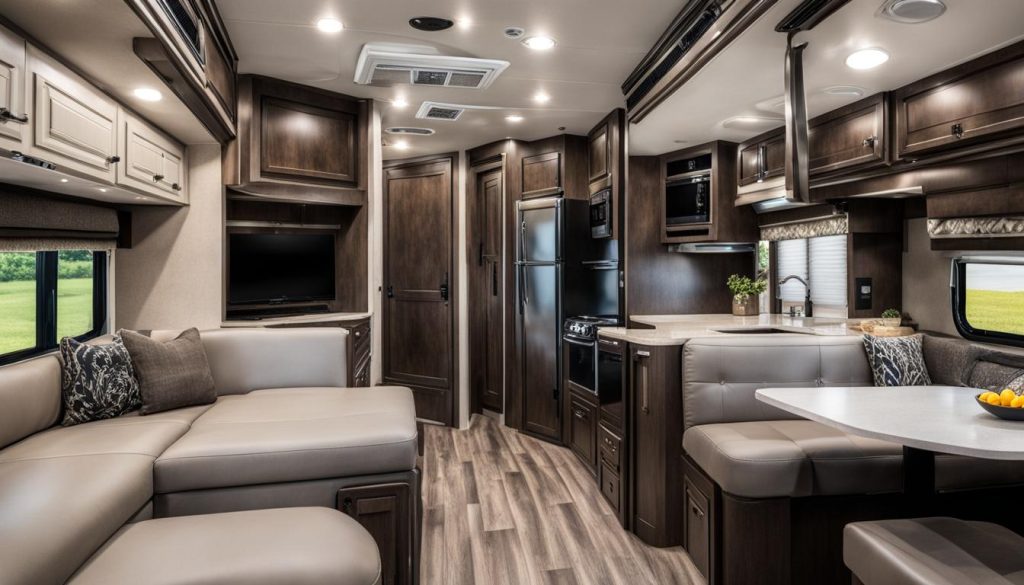 |
Pricing Your RV: Subjectivity vs. Objectivity
Pricing your RV can be a challenging task as it requires finding the right balance between subjective and objective factors. While it may be tempting to deduct wear and tear from the original purchase price, taking a subjective approach can help you determine a fair price that reflects the value of your RV.
Subjective pricing RV involves considering factors such as the overall condition of the RV, any unique selling points, additions, or improvements you have made, and the demand for similar RVs in the market. By highlighting these aspects in your listing, you can justify a higher price and attract potential buyers who appreciate the value you provide.
On the other hand, objective pricing RV relies on using resources like NADAguides or Kelley Blue Book to assess the market value of your RV based on factors such as its age, make, model, features, and overall condition. These valuation tools provide insights into what similar RVs are being sold for in the market, helping you set a competitive price that appeals to potential buyers.
It’s important to strike a balance between subjective and objective pricing RV. Being transparent about any flaws or issues with your RV allows buyers to make informed decisions. By providing a comprehensive and honest listing, you can set realistic expectations and avoid potential conflicts or disappointments.
Remember, pricing your RV is not just about maximizing profit but also about finding the right buyer who sees the value you offer. By considering both subjective and objective factors, you can set a price that reflects the true worth of your RV while attracting serious buyers.
| Subjective Pricing RV | Objective Pricing RV | RV Valuation |
| ———————-| ——————–| ———— |
| Dependent on the overall condition, unique selling points, and improvements made to the RV | Based on market value determined by resources like NADAguides or Kelley Blue Book | Factors in age, make, model, features, and condition |
| Justifies a higher price based on the value provided by the RV | Sets a competitive price based on market demand | Guides sellers in setting a realistic price |
| Highlights the unique aspects of the RV to attract buyers | Considers comparable RVs to determine a fair price | Guages the true worth of the RV in the market |
| Requires transparency about any flaws or issues | Helps buyers make informed decisions | Avoids conflicts or disappointments |
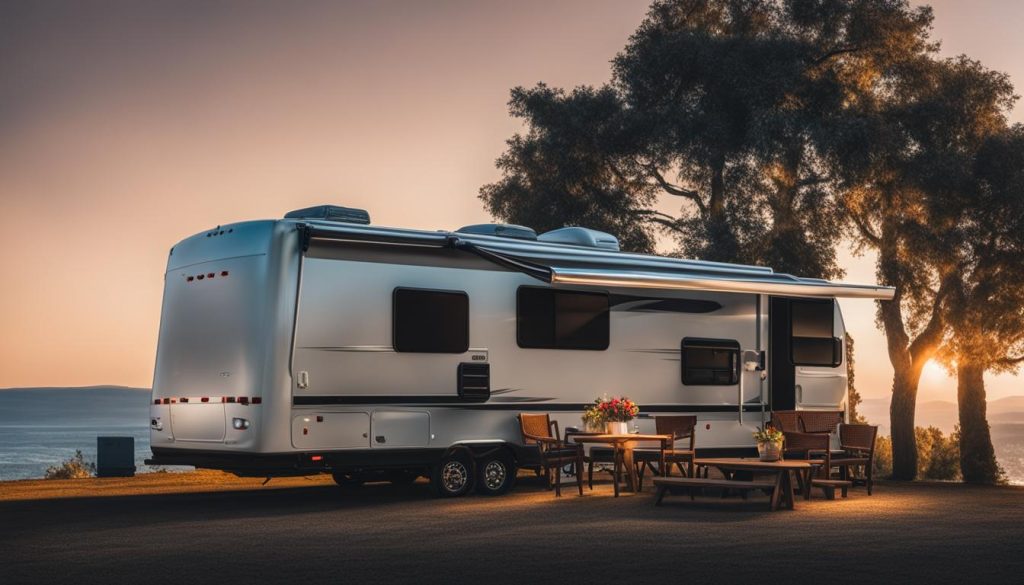
Selling Options: Private Sale, Dealership Trade-In, or Consignment
When it comes to selling your RV, you have three main options to consider: selling it privately, trading it in at a dealership, or consigning it. Each option has its own advantages and considerations, so let’s explore them to help you make an informed decision.
Selling Privately
Choosing to sell your RV privately gives you full control over the selling process. You can set your own price, negotiate directly with potential buyers, and potentially earn the highest value for your RV. This option is ideal if you have the time and resources to market and sell your RV on your own terms.
However, selling privately also comes with responsibilities. You’ll need to advertise your RV effectively, respond to inquiries promptly, and handle all aspects of the sale, including paperwork and negotiations.
Trading-In at a Dealership
Trading in your RV at a dealership offers convenience and a quick sale. You can bring your RV to the dealership, receive an offer, and potentially trade it for a new vehicle or receive cash payment. This option is suitable if you’re looking for a hassle-free selling experience.
Keep in mind that the price offered by the dealership may be lower than what you could get through a private sale. Dealerships consider potential repairs and profit margin when making an offer. If getting the highest value for your RV is your priority, selling privately may be a better option.
Consigning Your RV
Consigning your RV combines elements of both a private sale and a dealership trade-in. With consignment, you retain ownership while the dealership handles the selling process for you. This option can save you time and effort as the dealership takes care of marketing, negotiations, and paperwork on your behalf.
However, similar to trading in at a dealership, the price offered through consignment may be lower than what you could get through a private sale. It’s important to consider your priorities and goals when deciding between consignment and other selling options.
| Selling Option | Advantages | Considerations |
|---|---|---|
| Selling Privately | Full control over the selling process Potential to earn the highest value for your RV |
Time and effort required Responsibilities of advertising, negotiating, and paperwork |
| Trading-In at a Dealership | Convenience and quick sale Potential for trade-in towards a new vehicle |
Lower price offered Less control over the selling process |
| Consigning Your RV | Saves time and effort Dealership handles marketing and paperwork |
Potential lower price offered Less control over the selling process |
Consider your priorities, timeframe, and level of involvement you desire when choosing the best selling option for your RV. Whether you decide to sell privately, trade-in at a dealership, or consign your RV, there is a selling option that will align with your needs and preferences.
Selling Privately: Online Listings and Marketing
If you want maximum control over the selling process of your RV, selling it privately through online listings is the way to go. By utilizing popular platforms like Facebook Marketplace and Craigslist, you can reach a wide audience of potential buyers. However, to effectively market your RV online and attract interested buyers, you should also consider utilizing RV-specific classified websites like RVT.com. These websites are specifically tailored to RV enthusiasts and provide a targeted audience for selling your RV.
When listing your RV online, it’s crucial to make a good first impression. High-quality photos are essential to showcase the features and condition of your RV. Take photos from different angles, both inside and outside, to give potential buyers a comprehensive view. Additionally, write a detailed and accurate description that highlights the unique features, benefits, and selling points of your RV.
Setting a fair asking price is another important aspect of selling your RV online. Research the market value of similar RVs and consider factors such as age, condition, and any upgrades or renovations you’ve made. Pricing your RV competitively will attract potential buyers and increase your chances of selling it quickly.
To maximize your chances of finding a buyer quickly, it’s important to time your listing strategically. Peak RV buying seasons, such as after the holidays in January and February, tend to attract more interested buyers. Take advantage of these periods to increase your visibility and potential buyer pool.
Benefits of Selling Your RV Online:
- Maximum control over the selling process
- Wide reach and exposure to a large audience
- Opportunity to target RV enthusiasts through specialized classified websites
- Ability to showcase your RV with high-quality photos and detailed descriptions
- Flexible pricing options to attract potential buyers
- Increased chances of finding a buyer quickly, especially during peak RV buying seasons
When it comes to selling your RV, online listings and marketing provide a powerful platform to connect with potential buyers. By utilizing popular online platforms and targeted RV-specific classified websites, you can effectively showcase your RV’s unique features and set a fair asking price to attract interested buyers.
Selling to a Dealership: Pros and Cons
If you’re looking for a quick and convenient way to sell your RV, selling it to a dealership can be a viable option. Dealerships offer a hassle-free selling experience as they handle the entire process, from evaluating your RV to completing the necessary paperwork. This means you can avoid the time-consuming tasks of advertising your RV, negotiating with potential buyers, and dealing with the logistics of a private sale.
However, it’s important to consider the potential downsides of selling your RV to a dealership. One major drawback is that you may receive a lower price compared to what you could get through a private sale. Dealerships typically offer lower prices to account for potential repairs and to make a profit when reselling the RV. So, if maximizing your profit is your priority, selling privately might be a better option.
Before deciding to sell your RV to a dealership, consider your priorities. If convenience and a quick sale are what you’re after, selling to a dealership can be a great choice. On the other hand, if you have the time and resources to advertise your RV, negotiate with buyers, and complete the sales paperwork, a private sale could potentially fetch you a higher price.
FAQ
How can I sell my RV quickly?
To sell your RV quickly, start the selling process a few months before summer camping season to increase demand. Additionally, depersonalize and deep clean your RV, have it serviced, and stage it like a home. Take high-quality photos and describe its unique selling points and flaws. Including the original paperwork and offering to bring the RV to potential buyers can also help seal the deal.
When is the best time to sell my RV?
The best time to sell your RV is in spring, particularly April and May. This is the busiest season for RV sales, and buyers tend to have the most interest during this time. Starting the selling process a month or two before summer camping season can increase your chances of finding a buyer quickly. However, you can start preparing your RV for sale anytime to be ready when the market heats up.
How do I prepare my RV for sale?
To prepare your RV for sale, depersonalize and deep clean the space. Remove personal belongings and give the RV a thorough clean, including repairs and touch-ups. Investing in staging, such as new decor items, can also make the space more inviting. Opt for light colors to create an illusion of more space, but consider the preferences of your target market.
How do I price my RV for sale?
Pricing your RV can be a challenge. Use resources like NADAguides or Kelley Blue Book to determine a fair price based on market conditions and comparable RVs. Highlight any unique selling points, additions, or improvements you have made, and be transparent about any flaws or issues. Providing a comprehensive and honest listing can set realistic expectations for potential buyers.
What are my options for selling my RV?
There are three main options for selling your RV: selling privately, trading it in at a dealership, or consigning it. Selling privately allows you to have full control over the process, set your own price, and potentially earn the highest value for your RV. Trading it in at a dealership offers convenience and a quick sale, but the price offered may be lower than what you could get through a private sale. Consigning your RV combines elements of both private sale and dealership trade-in, with the dealership handling the selling process while you retain ownership. Consider your priorities and goals when choosing the best selling option for your RV.
How can I sell my RV online?
To sell your RV online, utilize platforms like Facebook Marketplace and Craigslist to reach a wide audience. Consider RV-specific classified websites like RVT.com for targeted marketing. Take high-quality photos, write detailed descriptions, and set a fair asking price to attract potential buyers. Timing your listing during peak RV buying seasons can increase your chances of finding a buyer quickly.
Should I sell my RV to a dealership?
Selling your RV to a dealership offers convenience and a quick sale, but it may result in a lower price compared to a private sale. Dealerships typically offer lower prices to account for potential repairs and profit margin. However, selling to a dealership eliminates the need to advertise, negotiate with buyers, and complete the sales paperwork. Consider whether speed or maximizing profit is your priority when deciding to sell to a dealership.

